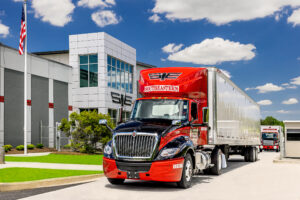It’d be pretty hard to find a driver willing accept a company driving position without even asking what the pay will be. In fact, most people would say that blindly taking any job without finding out the pay scale is not a wise move.
However, professional drivers who decide to buy a rig and strike out as owner-operators do this every day. In most cases, the main focus is on the truck itself — the price, financing, accessories, specifications and so on, seeking the most truck for the least investment.
How they’ll make money with that truck — including a backup plan if the first attempt doesn’t work out — is barely planned (if it’s planned at all).
The truth is, buying a truck means starting a business. Revenue is the lifeblood of any business, and it should be the first consideration in starting up a new one. It’s part of any business plan. To successfully estimate revenues, truck owners must have an understanding of how freight rates work.
Some owners choose to lease their equipment to a carrier, running within that carrier’s system in return for a set per-mile rate. Doing this allows them to take advantage of the carrier’s infrastructure. The carrier finds loads, does all the billing and collecting, maintains the appropriate safety records, and handles registration and permits. In many cases, the carrier provides the trailer, too. The truck owner drives (or hires a driver) and collects the money.
However, it’s important to understand that even per-mile rates are based on current freight rates.
For owner-operators who are compensated a percentage of the load revenue, freight rates directly impact the owner’s income. Those who depend on the spot market using load boards, brokers or both, might see the greatest impact from changing freight rates. That’s because the spot rate is the first to be impacted by market forces.
While contract rates are locked in by an agreement between a customer and carrier, spot rates represent what the market will bear. Shippers or the brokers who represent them make loads available, usually for the lowest rate they think they’ll be able to get. Truckers then either accept the loads at the posted rates or try to negotiate for better.
The biggest impact on those rates is usually the number of trucks competing for the available loads. Spot rates often temporarily rise over holiday weekends, such as Memorial Day or Labor Day, because the number of available trucks goes down as their owners park them for the holiday. Fewer trucks mean more competition between shippers to book them, driving rates up.
Knowing the market served and how it operates is important to successfully running a trucking business. In addition to temporary rate fluctuations caused by holidays, weather events and other occurrences, there is an overall freight cycle that generally takes several years to complete. The latest cycle, impacted by COVID-19 pandemic shutdowns and government stimulus checks, is a classic example.
The year 2019 was a solid year for trucking, but when COVID hit in 2020, many manufacturers shut down. In response, some carriers slowed or stopped hiring drivers, or even laid drivers off. As the economy started reopening, retailers needed to have products restocked and manufacturers needed to rebuild parts inventories. There was a boom in freight and there weren’t enough trucks to handle it all.
Rates skyrocketed.
In response to rising rates, carriers bought more trucks. Drivers quit company jobs to buy their own trucks, starting trucking businesses while rates were very favorable. New carrier registrations soared. The number of available trucks continued to climb — but so did inflation. Rumors of a coming recession cooled orders for more products, and the supply/demand pendulum swung the other way. Rates plummeted to their lowest level in years and have yet to recover.
That’s where we are today. At some point, rates will begin rising and the cycle will start again. In the meantime, equipment costs have risen sharply, as have interest rates for those borrowing to finance equipment. Starting a new trucking business while rates are bottoming and costs are soaring isn’t a sound business strategy.
Another thing that’s critical to a successful trucking business is understanding lane dynamics. Everyone wants to grab that load to Orlando with the really high rate — but freight coming out of Orlando usually doesn’t pay well. The options for an owner-operator might be to either sit for days waiting for a better rate or take a lower-paying load to get back to an area where rates are higher.
Ideally, truck owners will settle on a lane that provides good rates out and back. Some load boards, such as the DAT board, allow drivers to look up average freight rates by city or area so they can plan out loads in advance. This way, they can avoid loads destined for areas where outbound rates are low, or at least make sure they earn enough on the inbound run to cover the low rate for the outbound segment.
It’s also important to understand seasonality. A trucker with temperature-controlled equipment, for example, will do well to know when harvests occur in different regions of the country so loads can be accepted that position the equipment for the best rates. Flatbed truckers might study construction trends for loads of building materials and other products.
Finally, knowing what rates will be profitable can’t be estimated unless the business owner knows the cost per mile of running the truck. Keeping records of all costs associated with the business, including the driver’s pay and benefits, and then dividing that by the total of miles driven provides an idea of per-mile costs. When considering rates, it’s important to factor in ALL necessary miles, including empty miles driven to get to the pickup point.
A June 2023 study released by the American Trucking Research Institute (ATRI) calculated the industry average cost per mile in 2022 at $2.25. That amount may already have risen higher due to increased costs for insurance, parts and interest. Your own cost per mile may differ, depending on your route, fuel costs in your area, the cost of your equipment and other factors. However, it’s obvious that accepting a load at a rate lower than your operational cost is a recipe for failure.
Cliff Abbott is an experienced commercial vehicle driver and owner-operator who still holds a CDL in his home state of Alabama. In nearly 40 years in trucking, he’s been an instructor and trainer and has managed safety and recruiting operations for several carriers. Having never lost his love of the road, Cliff has written a book and hundreds of songs and has been writing for The Trucker for more than a decade.










Cliff that was a very accurate article, I agree with everything you wrote. We are a 1 truck owner operator company with own authority for last 6 years, before that we were leased on to a carrier for 4 years. Thank God we have direct freight customers because the Broker boards would put you out of business right now!